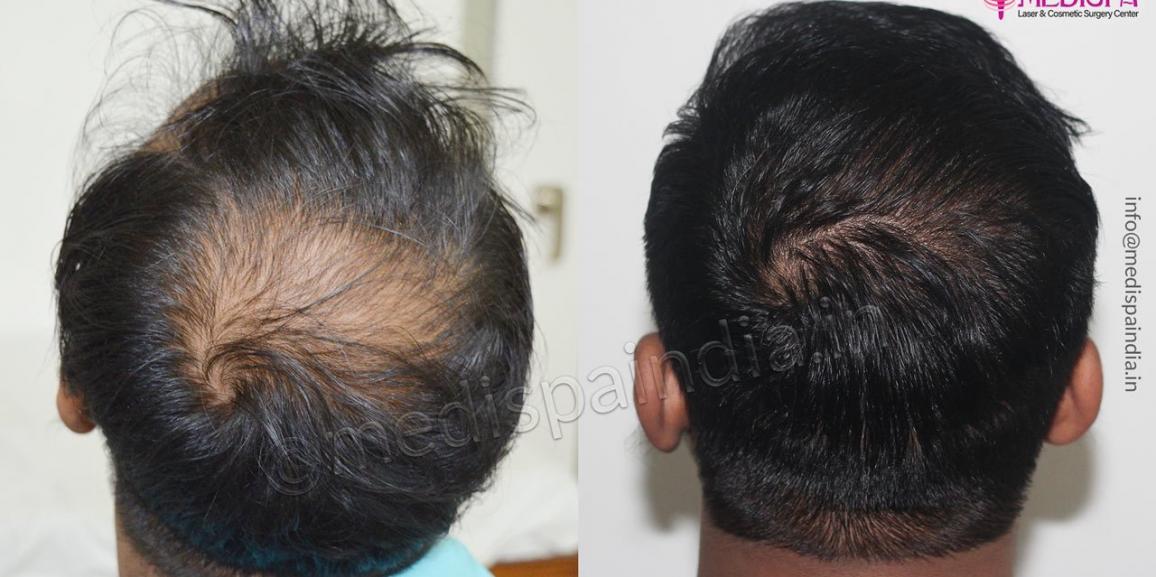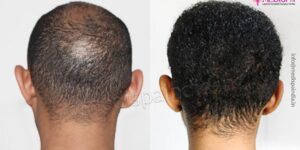
Are you experiencing hair loss and seeking a long-term cure?
Let’s find out what kind of baldness you have to begin with!
Permanent hair loss requires medical assistance, but temporary hair loss does not, and can be either temporary or permanent. Let’s talk especially about pattern baldness, one of the most prevalent types of baldness.
Stages of baldness
The Norwood categorization system is the most used method for listing the phases of baldness. The phases of baldness are described here:
Class I: Entire hairline lies high on the forehead and is not actually balding.
Class II: Triangular areas of recession in the sides of frontal area and minimal recession on mid frontal area.
Class III: Borderline case. Deepening of triangular recession or can include thinning of hair on the vertex.
Class IV: Further frontal hair loss and widening of hair loss from vertex but still a wide band of hair present separating frontal and vertex hair loss.
Class V: Widening of frontal and vertex hair loss and continual breaking of separation line of hairs between frontal and vertex baldness.
Class VI: Band or bridge of hair disappear merging frontal and vertex baldness.
Class VII: A band ofhair presents only in back and side of the head.
Hair transplant procedure
There aren’t many therapies for baldness, such as pills, PRP therapy, and hair transplants. Although drugs are proven to be beneficial, long-term results are not anticipated, and hair loss may halt if you stop using them. PRP therapy is useful, but it only has a limited role in the treatment of severe and advanced baldness.
Typically, a hair transplant is your last remaining option for baldness treatment. The method involves taking hair follicles from donor locations and transplanting them to the targeted bald area. Each patient has the option to choose the surgery at any stage of hair loss because it is voluntary.
There are two main methods used to carry out the procedure:
- FUT hair transplant: In this procedure, a tiny strip is taken from the donor region and transferred to the lab where it is further dissected to isolate each individual hair follicle. The hair grafts are then placed one by one in the prepared channels and individually implanted at the appropriate bald spot. Around 3000–3500 hair grafts may be collected with a FUT hair transplant in a single session, making it a useful procedure for situations of severe baldness.
- FUE hair transplant: In a FUE hair transplant, each hair follicle is individually retrieved from the donor region using a tool that resembles a punch. To remove the hair follicle, a punch is put into the skin of the donor location at a certain depth and angle. In the prepared channels, the removed hair follicles are transplanted to the appropriate bald region. With FUE hair transplant, the surgeon might remove between 2000 and 2500 hair grafts, making it an appropriate procedure for treating early hair loss patients and facial hair transplants.
How can hair transplantation help? Let’s find out!
How hair transplant can help?
Globally, hair transplants have gained a lot of popularity. Hair transplant in Delhi and Jaipur, India, have gained attention. The hair transplant process is renowned for its quality in these cities. Only a few clinics have set the bar high for exceptional hair transplant care. The cost of a hair transplant is also extremely reasonable in Delhi and Jaipur.
The Medipsa hair transplant clinic is the top hair transplant clinic in Delhi and Jaipur and is renowned for its exceptional amenities and offerings. We are devoted to provide hair transplants of the highest calibre at reasonable prices. At medispa clinics, you may receive the finest possible comprehensive treatment for hair loss all under one roof.
A hair transplant has a lot of advantages that can help you treat your baldness, including:
- Hair transplantation provides a lasting cure. Hand-selected and implanted just at the appropriate bald spot are the permanent hair roots.
- The hair transplant could result in the greatest amount of hair growth. Based on the density of hair in the donor location, hair growth is determined.
- The outcomes of the hair transplant are natural-looking. After a hair transplant, your own hair is transplanted to the targeted bald spot to ensure a natural appearance.
- A minimally intrusive solution to baldness is a hair transplant. There are no issues at all with the process.
- The hair transplant treatment is painless.
- These days, the surgery is more affordable.





